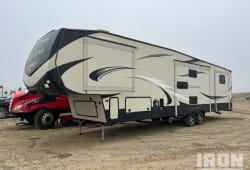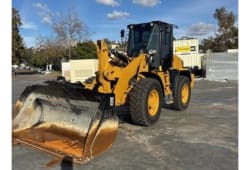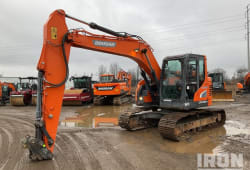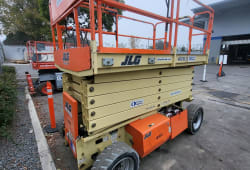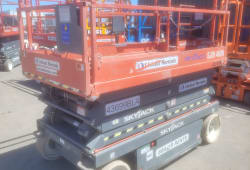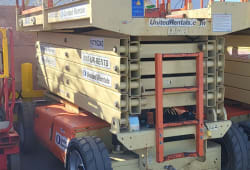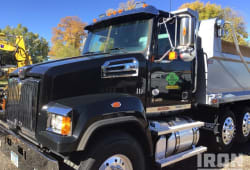The Cascade Sale™: A Smarter Way to Sell Used Equipment
9 Min read
)
August 21, 2025
Selling used equipment is one of the most critical, and often overlooked, steps in managing a fleet. Done right, it allows managers to reinvest in the fleet and show the profitability of a well run equipment department. But selling options can be confusing and sub-optimal: auction, sell yourself, trade-in, hire a broker? With so many choices - and so little time - most equipment managers default to whatever’s easiest.
That’s where the Cascade Sale™ comes in. It’s a simple, flexible strategy that helps you get the best price for your machines - without wasting time or taking unnecessary risks. It’s designed to maximize price realization across a fleet of assets while navigating real-world constraints like time, equipment condition, and each seller’s unique needs.
We’ll cover the components of the Cascade SaleTM, when and how to use each channel, how to avoid common mistakes, and the most important considerations to manage it. These recommendations come from hard-won lessons learned building Boom and Bucket’s managed marketplace and global insights from the Ritchie Bros. family of companies.
How It Works
The Cascade Sale™ is a simple, two-step plan:
Start by listing the equipment for sale directly to buyers (this is the retail step). It gives you the chance to get a higher price.
If it doesn’t sell in time, move it to auction. That guarantees it sells and helps you avoid holding costs.
This approach combines the best of both worlds - the upside of retail with the certainty of auction. It also gives you more control over timing, pricing, and the return you get.
At Boom & Bucket, we used this strategy to help fleet managers consistently earn more - often up to 20% higher returns.
:format(webp)) Fig1: A visual representation of a Cascade SaleTM
Fig1: A visual representation of a Cascade SaleTM
How to Run a Cascade Sale™
1. Know Your Goals
Before listing anything, get clear on two things:
When do you need the machine sold?
What’s the lowest price you’re willing to accept?
These two numbers - your sale deadline and your floor price - shape every other decision.
2. Start With Retail (But Know When to Skip It)
Begin by listing the machine for sale to end-users - on sites like Machinery Trader or Equipment Trader, or using a managed platform like Marketplace-E. Retail buyers typically pay more, and you can adjust the asking price over time.
However, retail isn’t always the right fit - especially if:
You have less than 30 days to sell.
The machine is old or in poor condition.
There's not much price difference between retail and auction.
In those cases, you may want to skip retail and go straight to auction.
3. Move to Auction With Confidence
If the machine hasn’t sold by the end of your retail window, don’t wait - cascade it to auction.
Auctions offer speed and certainty. If time is critical, go with unreserved auctions - which guarantee a sale. If you must hit a certain price, a reserve auction can work, but know that it might not sell on the first try and you might miss your sale deadline
The beauty of the Cascade Sale™ is that you don’t need every unit to sell at retail. Even if only some do, your overall returns will likely be better than using one channel alone.
Keys to a Successful Cascade Sale™
Choose the Right Sale Window
You can’t wait forever to sell. Machines lose value over time and cost money to sit - through financing, storage, insurance, or missed opportunities.
External factors can influence how quickly a machine must be sold. For example, a Joint Venture may need to sell its assets quickly at the end of the project to pay out the partners. Likewise, a rental company may have limited yard space and needs to make room for new machines.
Most sellers have the ability to choose their sale window. While it can be tempting to ‘wait for the right price,’ you need to consider holding costs when choosing how long to wait.
Understanding Holding Costs
Sitting machines generally incur 3 types of holding costs:
Direct costs are cash paid for the machine while it’s being sold. These can include financing costs if there’s a loan on the machine, advertising costs if selling independently, storage costs, maintenance costs, and insurance costs.
Devaluation refers to the decrease in value of a machine as it ages, regardless of its usage. Distinct from depreciation, which is an accounting term, devaluation is driven by the market. Rouse Analytics has developed category-level guidelines for devaluation based on their extensive market data.
Fig 2. Devaluation by equipment category
:format(webp))
*Source: Rouse market data analysis. Assumes 4-5 year old machine with usage held constant and accounts for industry inflation
Cost of capital is opportunity cost. If you sold the machine today and reinvested that money into your business, how much would you earn from that money? Larger corporations with stable revenue streams will have an established Weighted Average Cost of Capital, typically in the 5-10% range. Smaller private companies have more risk and a higher expectation of return, so their capital cost may be 20-30%. A financial services company might choose their commercial interest rate (what they’d earn if the money went into another loan).
We’ve provided a calculator [link here] to help estimate holding costs, but consider that a local contractor selling an excavator could be incurring 40% of the machine’s value in holding costs every year. For a $100K excavator that’s over $100 a day, or $10,000 per quarter!
Pick a sale window, commit to it, and be realistic about how long you can afford to wait.
Set a Smart Asking Price
Look at real data - comparable listings and recent auction results - to decide your asking price and determine auction value. These prices will define the zone of possible sale outcomes.
If retail and auction prices are close (say, within 10-15%), lean toward auction to avoid extra holding costs. This small split is most common in older machines and smaller items like small scissor lifts or light towers.
Price too high and you’ll scare off buyers, extending your sale window (and holding costs!). Use your asking price to drive outcomes. For example, pricing 10% below market can get you more buyer leads if you have a short sale window. Be willing to adjust your asking price down as you approach your target sale date.
Tip: Don’t use ‘Call for price.’ Our experiments have shown a significant decrease in buyer engagement when prices aren’t public - more so than overpriced assets. Most buyers don’t call to find the price, they just move on to another asset.
Give Buyers the Info They Need
Buyers want to feel confident. Give them what they need:
Pictures sell machines. Get at least 10 good photos - clean, clear, and detailed. Take the time to clean the machine before taking pictures, get some good ‘glamour shots’ at a 45 degree angle with an uncluttered background, and then focus on pictures of key components like the cab and hydraulics.
Provide honest descriptions of wear and tear.
Key specs and upgrades (e.g., GPS, recent rebuilds).
Include service records - these can bump the sale price by 5–15%.
Hiding flaws usually backfires. Honesty earns trust - and often higher offers.
Consider Getting Help
If you're short on time or don’t want to deal with the hassle, a full-service consignment partner can be a great option. The right partner can:
Market your machine to a bigger audience.
Offer buyers financing, shipping, and even warranties. These value added services unlock higher price points for you as the seller.
Handle the sales process and follow-up.
Choose partners with national or global footprints for classifieds or auction consignment - the larger customer audiences are, the better your results will be.
Yes, you’ll pay a fee - but it often pays for itself in better outcomes and less time wasted.
Special Note for Rental Companies
Rental companies can run a Cascade Sale™ too - but with a few twists.
Ideally, you’d sell while the machine is still on rent (to keep it earning money). But this means you’ll need regular photo and usage updates, and a plan for what happens if a buyer wants the machine mid-rental.
If you park the machine for sale, make sure to count that downtime in your holding cost calculations. Use your utilization-adjusted rental rate as your cost of capital, and add in direct costs and devaluation.
A Practical Example
Tom is an equipment manager for a regional excavation company in the midwest. He’s selling a 2015 Caterpillar 320 with 8,500 hours that the company owns free and clear. After doing a bit of market research, he sees that other sellers are asking approximately $80K for similar machines, and that they’ve been auctioning for around $65K. The split is large enough that Tom decides he wants to run a Cascade SaleTM.
The company’s CFO tells Tom that the company’s cost of capital is 25%. He knows the machine will devalue at 9% per year and there’s a 1% insurance charge. He estimates he’ll need a tech to spend 2 hours per month running and checking the machine even if it sits, which he values at $100 / hr or $200 per month. With annual cost of capital, devaluation, and insurance at 35% cost plus $200 per month in maintenance, Tom calculates his inventory holding cost for the machine at about $28,000 per year. His retail value increase will be eaten up by holding costs after about 6 months. After conferring with the CFO, they decide they’d like to restrict the sale window to 4 months so they can have the machine off the books by the end of November and invest in new fleet to take advantage of Section 179 bonus depreciation. They set a target sale price at $70K and consign the machine to a provider with an asking price of $80K. If Tom lands a buyer in the first 3 months at or above $70K, great. But even if he has to cascade to an auction after 3 months and gets $65K he has liquidity within an acceptable window that wasn’t wasteful.
The Bottom Line
The Cascade Sale™ is a smarter, more flexible way to sell used equipment. It helps you:
Maximize returns.
Sell faster.
Reduce idle time.
Make better financial decisions.
Whether you handle the process yourself or work with a trusted partner, the Cascade Sale™ is the best way to get more value from your fleet.
Looking to sell your equipment, check out our Seller Service page here to get started today.

Aaron Kline is the Co-Founder and COO of Boom & Bucket, where he leverages his extensive leadership experience to revolutionize the heavy equipment industry. With a background in building scalable processes and teams from his time as a Naval officer and executive roles in tech, Aaron focuses on introducing cutting-edge technology to construction and agriculture markets. Before Boom & Bucket, he held leadership positions at Skylo and Yard Club (acquired by Caterpillar), and he’s passionate about fostering innovation and driving efficiency in under-digitized industries.
